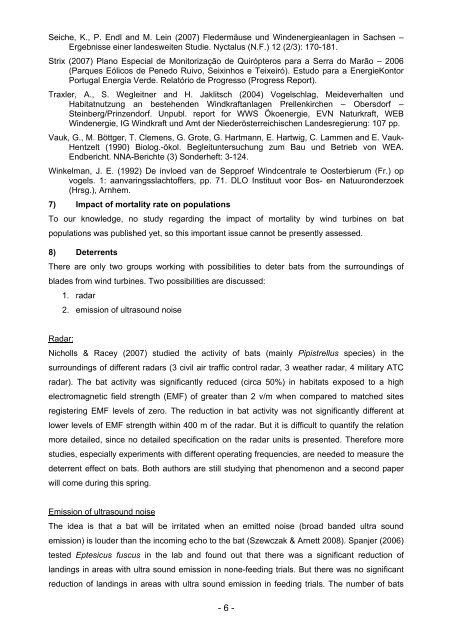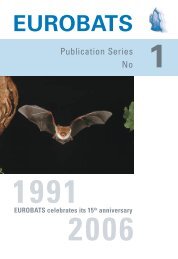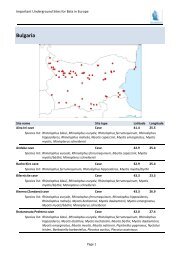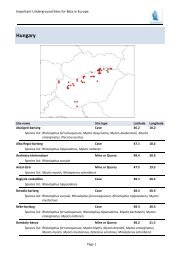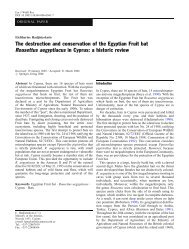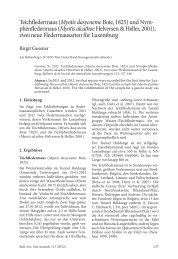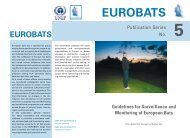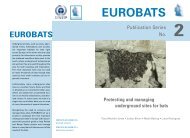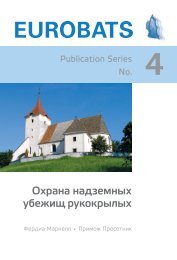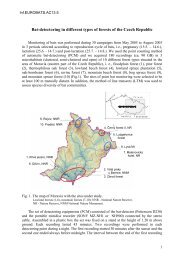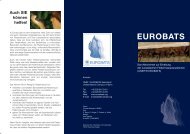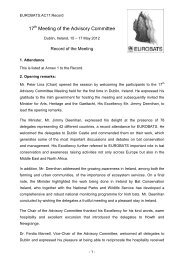Tochni / Larnaca, Cyprus, 11 – 13 May 2009 - Eurobats
Tochni / Larnaca, Cyprus, 11 – 13 May 2009 - Eurobats
Tochni / Larnaca, Cyprus, 11 – 13 May 2009 - Eurobats
Create successful ePaper yourself
Turn your PDF publications into a flip-book with our unique Google optimized e-Paper software.
Seiche, K., P. Endl and M. Lein (2007) Fledermäuse und Windenergieanlagen in Sachsen –<br />
Ergebnisse einer landesweiten Studie. Nyctalus (N.F.) 12 (2/3): 170-181.<br />
Strix (2007) Plano Especial de Monitorização de Quirópteros para a Serra do Marão – 2006<br />
(Parques Eólicos de Penedo Ruivo, Seixinhos e Teixeiró). Estudo para a EnergieKontor<br />
Portugal Energia Verde. Relatório de Progresso (Progress Report).<br />
Traxler, A., S. Wegleitner and H. Jaklitsch (2004) Vogelschlag, Meideverhalten und<br />
Habitatnutzung an bestehenden Windkraftanlagen Prellenkirchen – Obersdorf –<br />
Steinberg/Prinzendorf. Unpubl. report for WWS Ökoenergie, EVN Naturkraft, WEB<br />
Windenergie, IG Windkraft und Amt der Niederösterreichischen Landesregierung: 107 pp.<br />
Vauk, G., M. Böttger, T. Clemens, G. Grote, G. Hartmann, E. Hartwig, C. Lammen and E. Vauk-<br />
Hentzelt (1990) Biolog.-ökol. Begleituntersuchung zum Bau und Betrieb von WEA.<br />
Endbericht. NNA-Berichte (3) Sonderheft: 3-124.<br />
Winkelman, J. E. (1992) De invloed van de Sepproef Windcentrale te Oosterbierum (Fr.) op<br />
vogels. 1: aanvaringsslachtoffers, pp. 71. DLO Instituut voor Bos- en Natuuronderzoek<br />
(Hrsg.), Arnhem.<br />
7) Impact of mortality rate on populations<br />
To our knowledge, no study regarding the impact of mortality by wind turbines on bat<br />
populations was published yet, so this important issue cannot be presently assessed.<br />
8) Deterrents<br />
There are only two groups working with possibilities to deter bats from the surroundings of<br />
blades from wind turbines. Two possibilities are discussed:<br />
1. radar<br />
2. emission of ultrasound noise<br />
Radar:<br />
Nicholls & Racey (2007) studied the activity of bats (mainly Pipistrellus species) in the<br />
surroundings of different radars (3 civil air traffic control radar, 3 weather radar, 4 military ATC<br />
radar). The bat activity was significantly reduced (circa 50%) in habitats exposed to a high<br />
electromagnetic field strength (EMF) of greater than 2 v/m when compared to matched sites<br />
registering EMF levels of zero. The reduction in bat activity was not significantly different at<br />
lower levels of EMF strength within 400 m of the radar. But it is difficult to quantify the relation<br />
more detailed, since no detailed specification on the radar units is presented. Therefore more<br />
studies, especially experiments with different operating frequencies, are needed to measure the<br />
deterrent effect on bats. Both authors are still studying that phenomenon and a second paper<br />
will come during this spring.<br />
Emission of ultrasound noise<br />
The idea is that a bat will be irritated when an emitted noise (broad banded ultra sound<br />
emission) is louder than the incoming echo to the bat (Szewczak & Arnett 2008). Spanjer (2006)<br />
tested Eptesicus fuscus in the lab and found out that there was a significant reduction of<br />
landings in areas with ultra sound emission in none-feeding trials. But there was no significant<br />
reduction of landings in areas with ultra sound emission in feeding trials. The number of bats<br />
- 6 -


